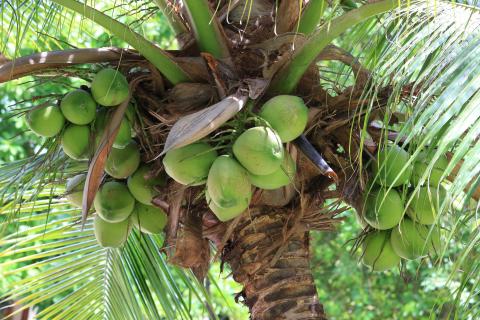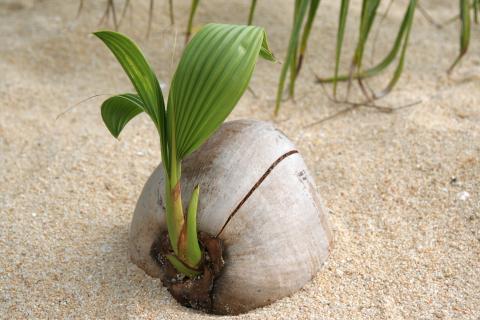Coconut tree
The coconut tree is considered the ultimate tropical plant. Here’s the correct way to care for this exotic houseplant.
Factsheet
- Growth type
-
- small tree
- Growth height (from)
- from 300 cm to 600 cm
- Growth width (from)
- from 200 cm to 300 cm
- Flower characteristics
-
- unimpressive
- Leaf color
-
- green
- page format
-
- feathered
- Sheet properties
-
- evergreen
- Light
-
- sunny
- Soil type
-
- sandy
- Soil Moisture
-
- moderately humid to humid
- ph value
-
- weakly acidic
- Lime compatibility
-
- sensitive to lime
- Nutrient requirements
-
- moderately nutritious
- Humus
-
- low humus
- Decorative or utility value
-
- Leaf ornaments
- picturesque growth
- Winter Hardness
-
- frost-sensitive
- Use
-
- Interior greening
- Planters
- Winter garden
The Coconut tree (Cocos nucifera) is the very definition of a tropical plant. This plant from the humid, warm tropics, forms 30 to 40 Coconuts form a year, in ideal locations it can grow up to 150 nuts. The Coconut tree can reach a height of up to 66 feet, the trunk has a diameter of 7.87 to 12 inches. The floating, salt-water resistant seeds have enabled the plant to spread across almost every tropical coast.
Coconuts have been cultivated for over 3000 years, and all parts of the Coconut tree are used and processed. Cocopeat is obtained from the fibrous fruit capsules of the coconut and is one of the most important ingredients in turf-free potting soil. The fibers are also used to manufacture coconut cord, which is used as tie material for newly planted trees. The leaves of the Coconut tree are used to make brooms and basket ware in the tropics. The fronds are also used as roofing material.
Coconut trees do not grow any branches. As a tuft tree, it does not grow a crown, rather the branch ends have a dense wreath of large leaves. In the tropics, a tuft consists of approximately 30, 10 to 23 feet long, pinnate leaves which are divided into leaf segments. After germination, the nut, which protrudes half way out of the earth, initially forms head-height, v-shaped seedling leaves.
As a tropical plant, the Coconut tree loves warm temperatures and does not tolerate frost. When selecting the location, you should also always consider that the Coconut tree always needs plenty of light. A spot on a bright, south-facing window is an emergency solution, a location in a conservatory under a glass roof is ideal. It requires temperatures of around 72 degrees Fahrenheit in the summer and no less than 61 degrees Fahrenheit in the winter. The Coconut tree can be brought outside on warm, sunny days. However, you need to take care then that the temperature does not drop lower than 68 degrees Fahrenheit in the evening, as the Coconut tree stops growing in extreme temperature fluctuations.
It is essential that the plant substrate is loose and permeable. A slightly acidic, sandy and rather low humus mixture is ideal. Older specimens thrive best in normal palm soil. If you use garden soil, this needs to be loosened with some sand.
Coconut trees are extremely thirsty. Water the palm tree with soft, luke-warm water if you can, or rain water if possible, as soon as the substrate has dried on the surface. Avoid waterlogging and do not water the nut directly or leave it standing in water as otherwise there is a risk of rot and the Coconut tree may die. It requires less watering in the winter.
The Coconut tree should be given a green plant fertilizer roughly every two weeks from April to September. Young plants should only be given fertilizer after two years as the Palm trees are fed nutrients from the nut for a relatively long period.

You should repot the Palm tree in a larger pot which is as deep as possible directly after the purchase, as the plant forms a deep tap root. Otherwise, the Palm tree will generally demise after two to three years, when the nut nutrient supply has been used up and it has not been able to form a sufficiently large root network. Ideally, you should ensure when you purchase the plant that the pot is not too small and flat and that the palm tree has formed a lot of roots. The nut should be peeking half out of the soil.
As the Coconut tree grows really quickly in ideal conditions, the young plant should be replanted in a larger pot every two years in the spring. With older specimens, a tri-annual repotting rhythm is sufficient.
In addition to light and warmth, the maximum possible humidity is also very important. As this is not easily achieved in the winter with heated air, you should thoroughly spray your Coconut tree every two to three days with rain water. A wide plant saucer filled with clay pebbles under the plant container which always retains a little water can also enrich the air humidity.
Coconut trees are grown from a coconut. The germ is located in the center of the nut, which has three germinating holes. It initially grows in the still encapsulated coconut and then penetrates through one of the holes into the light. You can obtain coconuts which are suitable for germination in delicatessens and sometimes even in the supermarket. Begin by removing the fibrous case of the coconut and place the nut half deep in a pot with a sandy substrate.

Cover the nut with a film hood and keep it evenly moist at a temperature of at least 77 degrees Fahrenheit. With some luck, the seedling will appear after eight months. When the roots have grown through the shell, the seedling together with the nut shell can be planted in a larger container.
Brown leaf tips indicate dry room air. Regular spraying or an air humidifier can help. Spider mites are also a regular occurrence when the air is too dry. These can be recognized by silvery, matt leaves, and the webs of the spider mites in the leaf axils. Infested plants should be immediately isolated and the remaining specimens treated with a preventative soft soap solution. Regularly spraying leaves also helps to prevent spider mites. You can also prevent this by giving the palm tree a good shower or placing it in a bath. This treatment needs to be repeated several times. Incidentally, you can recognize a healthy Coconut tree from its shining, green leaves. It should have at least five palm fronds.

